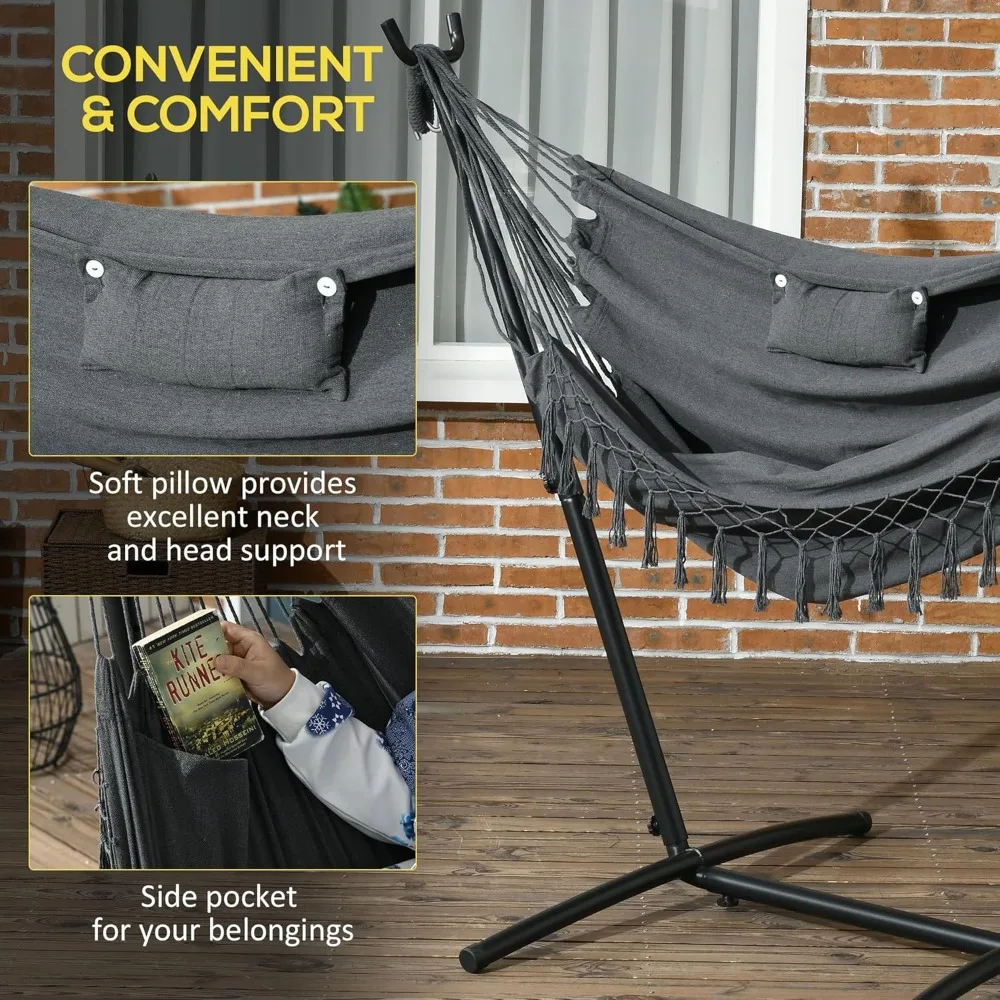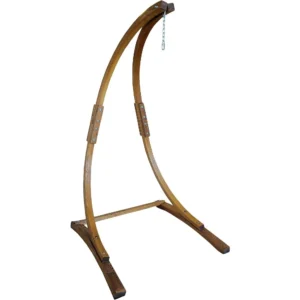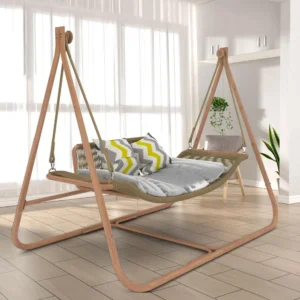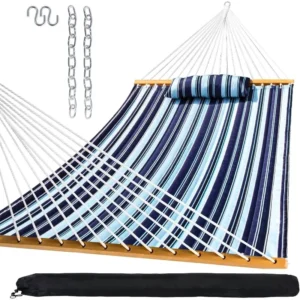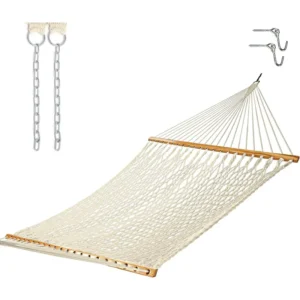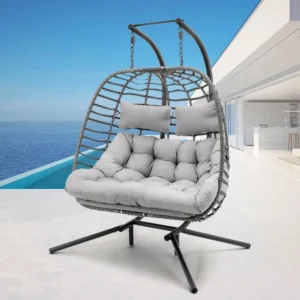Why Your Porch Hammock Swing Fabric Choice Matters
Selecting the right fabric for your porch hammock swing isn’t just about picking a pretty color or pattern. This decision directly impacts how much enjoyment you’ll get from your outdoor relaxation space, and for how long.
The fabric you choose determines:
- Comfort level during those long afternoon naps or evening reading sessions
- Durability against daily use, weight, and stretching
- Weather resistance capabilities in various outdoor conditions
- Maintenance requirements throughout the seasons
- Visual appeal that complements your porch aesthetics
Outdoor fabrics face challenges that indoor materials simply don’t encounter. Constant UV exposure can fade vibrant colors to a dull shadow of their former glory. Summer rainstorms can leave fabrics soggy and prone to mildew. Humidity can break down fibers prematurely, while temperature fluctuations test the limits of material integrity.
Poor fabric choices can lead to unfortunate consequences. Imagine hosting friends only to have your hammock swing develop unsightly mildew spots, or discovering that after just one season, your once-vibrant fabric has faded to a washed-out version of itself. Understanding the ultimate guide to porch swing hammocks will help you avoid these disappointments and make a choice that provides years of comfortable relaxation.
Understanding Key Fabric Properties for Outdoor Performance
Before diving into specific fabric types, it’s essential to understand the key properties that determine how a fabric will perform in outdoor settings. These characteristics form the foundation for comparing different options and making an informed choice.
Durability & Strength
Durability refers to how well a fabric withstands regular use without showing signs of wear. For hammock swings, this includes:
- Tensile strength: The amount of force a fabric can withstand before breaking
- Abrasion resistance: How well it handles friction and rubbing
- Tear strength: Resistance to ripping once a small tear begins
These factors are particularly important for hammock swings that support body weight and experience constant tension.
Weather Resistance Trio
Outdoor fabrics must contend with the elements:
- UV resistance: Protects against color fading and fiber degradation from sun exposure
- Water repellency: Determines how effectively water beads up and rolls off rather than soaking in
- Mold and mildew resistance: Prevents the growth of fungi that can stain, smell, and degrade fabric
The specific qualities of best materials for hammock chairs for porches demonstrate how these properties work together to create comfortable, durable outdoor seating.
Comfort Factors
A hammock swing should invite relaxation through:
- Texture: The feel against your skin (smooth, rough, soft)
- Breathability: How well air circulates through the material
- Temperature regulation: Ability to remain comfortable in varying temperatures
Maintenance Requirements
Different fabrics demand different levels of care:
- Washability: Whether the fabric can be machine washed, hand washed, or requires professional cleaning
- Stain resistance: How easily spills and dirt can be removed
- General care: Regular maintenance needed to maintain appearance and performance
Eco-Friendliness
Increasingly important to many consumers:
- Material sourcing: Renewable vs. non-renewable resources
- Production methods: Water usage, chemical treatments, energy consumption
- End-of-life considerations: Biodegradability or recyclability
Aesthetic Qualities
The visual and tactile appeal:
- Color range: Variety of available hues
- Pattern options: From solid colors to intricate designs
- Texture variations: Visual dimension and interest
Understanding these fundamental properties allows you to make informed comparisons between different guide to choosing outdoor fabric for hammocks and select one that best meets your specific needs.
The Science of Weather-Resistant Fabrics
The remarkable durability of modern outdoor fabrics isn’t accidental—it’s the result of advanced manufacturing techniques and treatments specifically designed to combat environmental challenges.
Solution-Dyeing vs. Traditional Dyeing
Traditional fabrics are dyed after weaving—color is applied to the surface of already-created fabric. Solution-dyed fabrics, however, incorporate color directly into the liquid synthetic material before it’s formed into fiber. Think of it like this: traditional dyeing is like painting a carrot, while solution-dyeing is like growing a carrot that’s colored all the way through.
This distinction is crucial because:
– When surface-dyed fabrics fade, they lose their color completely
– When solution-dyed fabrics experience UV exposure, the color remains consistent throughout the fiber
This explains why premium solution-dyed fabrics can maintain vibrant colors for 5+ years in full sun conditions.
Water-Resistant Treatments
Water resistance in fabrics typically comes from one of several treatments:
– Silicone-based coatings create a flexible barrier that allows breathability
– Fluorocarbon treatments bond to fibers at a molecular level, creating tiny “umbrellas” over the fabric
– Acrylic coatings form a more rigid protective layer
These treatments cause water to bead up and roll off rather than soaking through to your hammock’s filling or frame. Understanding outdoor fabric hammocks guide principles can help you maintain these protective properties longer.
Anti-Microbial Science
Mildew and mold thrive in damp, warm environments—precisely the conditions many porch hammocks experience. Anti-microbial treatments work by:
– Creating an inhospitable surface for spore attachment
– Disrupting fungal reproduction capabilities
– Preventing the organic decomposition that feeds microbial growth
The effectiveness of these treatments often correlates directly with a fabric’s price point, which explains why premium options tend to resist mildew much more effectively than budget alternatives.
Top Fabric Choices for Porch Hammock Swings
Solution-Dyed Acrylics: Premium Performance for Serious Relaxation
Solution-dyed acrylic represents the gold standard for outdoor hammock swing fabrics, with brands like Sunbrella and Outdura leading the market. These fabrics are manufactured by mixing color pigments with liquid acrylic before the fibers are even formed, resulting in color that permeates the entire fiber rather than just sitting on the surface.
Pros:
– Exceptional UV resistance (1,500+ hours of direct sunlight without significant fading)
– Superior colorfastness that lasts 5-7 years even in harsh conditions
– Excellent water repellency with quick-drying properties
– Natural resistance to mildew and mold growth
– Soft, cotton-like feel that remains comfortable against skin
– Breathable weave that prevents heat buildup on warm days
– Available in hundreds of colors and patterns
Cons:
– Premium price point (typically $30-60 per yard)
– Can feel slightly stiffer than cotton when new (softens with use)
– May require specific cleaning products for deep stains
– Limited stretch compared to some alternatives
Solution-dyed acrylic fabrics typically carry 3-5 year warranties against fading and deterioration, reflecting manufacturers’ confidence in their performance. For those planning to keep their hammock swing in place year-round or in challenging weather conditions, the higher initial investment generally pays for itself through extended longevity and reduced replacement costs.
The outdoor fabric hammocks guide provides more detailed information about how these premium materials maintain their appearance and performance over time.
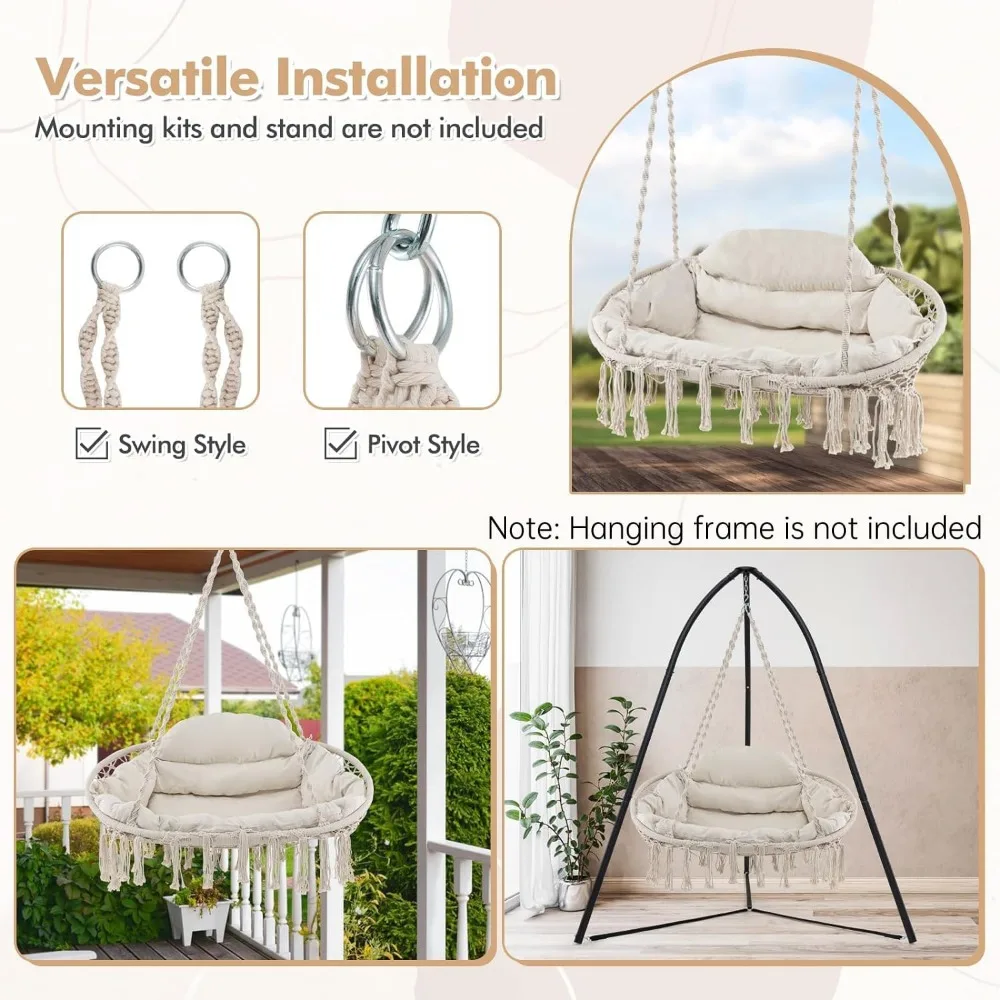
Polyester: The Versatile Middle-Ground Option
Polyester fabrics offer an excellent balance of performance and affordability for hammock swings, making them one of the most widely used materials in the market. As a synthetic fiber, polyester is manufactured from petroleum-based chemicals that are extruded and woven into fabrics of varying weights and textures.
Pros:
– Strong resistance to stretching and shrinking
– Good UV resistance (especially solution-dyed polyester)
– Dries quickly after rain or morning dew
– Readily available in numerous colors and patterns
– More affordable than acrylic options ($15-30 per yard)
– Resistant to wrinkles and holds shape well
– Relatively easy to clean and maintain
Cons:
– Standard polyester fades faster than solution-dyed acrylic
– Can feel less breathable in hot, humid conditions
– Sometimes has a “synthetic” hand feel
– Mid-range mildew resistance (better than cotton, worse than acrylic)
– Lower-quality polyester may pill over time
The performance gap between budget polyester and premium polyester is substantial. Budget options (often under $15/yard) may begin showing signs of fading within a single season of sun exposure, while higher-quality solution-dyed polyester can maintain color integrity for 2-3 years. For moderate climates or porches with partial coverage, polyester provides excellent value.
Many of our fabric hammock sets utilize high-quality polyester that balances durability with comfort for everyday enjoyment.
Olefin (Polypropylene): The Stain-Fighting Champion
Olefin, also known as polypropylene, is a synthetic fabric with unique properties that make it particularly well-suited for certain hammock swing applications. It’s created through a process called extrusion, where polypropylene pellets are melted and formed into fibers.
Pros:
– Exceptional stain resistance (most stains can be removed with just water)
– Inherently waterproof at the fiber level (doesn’t rely on treatments)
– Extremely quick drying after exposure to moisture
– Lightweight yet surprisingly strong
– Excellent colorfastness due to solution dyeing
– More affordable than acrylic options
– Resistant to chemical damage from cleaners
Cons:
– Lower melting point than other synthetics (avoid placing near fireplaces)
– Can feel slightly rougher than acrylic or cotton
– Less dimensionally stable under heavy loads
– Limited selection of textures and weaves
– Can be susceptible to oil-based stains
Olefin truly shines in high-traffic environments where food and beverages might be regularly enjoyed. Its stain-fighting capabilities are impressive—red wine, ketchup, and even sunscreen can often be removed with just water and mild soap. For families with children or those who frequently entertain on their porch, olefin provides peace of mind along with performance.
Cotton and Natural Fibers: Comfort with Caveats
Cotton remains popular for its unmatched softness and natural appeal, particularly in duck cloth and canvas forms designed for somewhat heavier use. As a natural fiber derived from cotton plants, it offers a traditional aesthetic and feel that synthetics struggle to replicate.
Pros:
– Superior comfort and softness against skin
– Excellent breathability in hot weather
– Natural look and texture that many prefer
– Biodegradable and environmentally friendly
– Often less expensive initially
– Absorbs moisture rather than repelling it (can be good in dry climates)
– Authentically traditional appearance
Cons:
– Poor resistance to moisture (absorbs water readily)
– Highly susceptible to mildew and mold growth
– Minimal UV resistance leads to faster fading
– Requires regular maintenance and cleaning
– Shorter lifespan in outdoor applications (1-2 seasons typically)
– May shrink when wet
– Heavier when wet, taking longer to dry
Cotton hammock swings work best in covered porch settings with minimal exposure to direct weather elements. They’re ideal for seasonal use where they can be stored during inclement weather periods. Many enthusiasts find the superior comfort worth the additional maintenance requirements.
For those who value premium comfort, our quilted fabric hammock sets offer enhanced softness while mitigating some of cotton’s traditional drawbacks.
Synthetic Blends and Specialty Fabrics: Best of Both Worlds
Fabric blends and specialty textiles represent the cutting edge of outdoor performance, combining the best attributes of different materials to create superior options for discerning hammock enthusiasts. These engineered fabrics often feature proprietary technologies and manufacturing methods.
Specific Specialty Options:
– DuraCord: Combines the softness of cotton with polyester’s durability and quick-drying properties
– Textilene: A PVC-coated polyester mesh offering excellent airflow and water drainage
– Phifertex: A vinyl-coated polyester mesh engineered for structural stability and resistance to sagging
– Olefin-Polyester Blends: Merging stain resistance with improved texture and dimensional stability
– Recycled Plastic Fabrics: Eco-friendly options made from reclaimed plastic bottles with surprisingly soft hand feel
Pros:
– Engineered to address specific performance challenges
– Often incorporate the best properties of multiple materials
– Many feature advanced treatments for enhanced weather resistance
– Specialty weaves can provide unique textures and appearances
– Some offer superior ventilation through mesh constructions
– May include antimicrobial protection built into the fiber
– Often backed by robust warranties
Cons:
– Premium price points for cutting-edge technology
– Sometimes limited color and pattern availability
– May require specialty cleaning products
– Less widely available than standard fabric options
These specialty fabrics often appear in premium porch swing chair sets where performance requirements are highest and comfort expectations cannot be compromised.
Fabric Performance Comparison: Making Your Decision
When selecting the ideal fabric for your porch hammock swing, direct comparison across key performance metrics helps clarify which option best meets your specific needs:
| Fabric Type | Weather Resistance (UV/Water) | Durability | Comfort | Maintenance | Cost | Overall Value |
|---|---|---|---|---|---|---|
| Solution-Dyed Acrylic | ★★★★★ | ★★★★☆ | ★★★★☆ | ★★★★☆ | $$$ | ★★★★★ |
| Polyester | ★★★☆☆ | ★★★☆☆ | ★★★☆☆ | ★★★★☆ | $$ | ★★★★☆ |
| Olefin | ★★★★☆ | ★★★☆☆ | ★★☆☆☆ | ★★★★★ | $$ | ★★★★☆ |
| Cotton/Canvas | ★☆☆☆☆ | ★★☆☆☆ | ★★★★★ | ★☆☆☆☆ | $ | ★★☆☆☆ |
| Synthetic Blends | ★★★★☆ | ★★★★☆ | ★★★★☆ | ★★★★☆ | $$$ | ★★★★☆ |
These ratings reflect typical performance under standard outdoor conditions. Weather resistance combines UV protection and water repellency, while durability measures expected lifespan under regular use. Comfort assesses how the fabric feels against skin, and maintenance reflects the ease of keeping the fabric clean and attractive.
Note that within each category, significant variation exists between budget and premium options. A high-quality polyester, for instance, may outperform a budget acrylic despite the general category trends shown above.
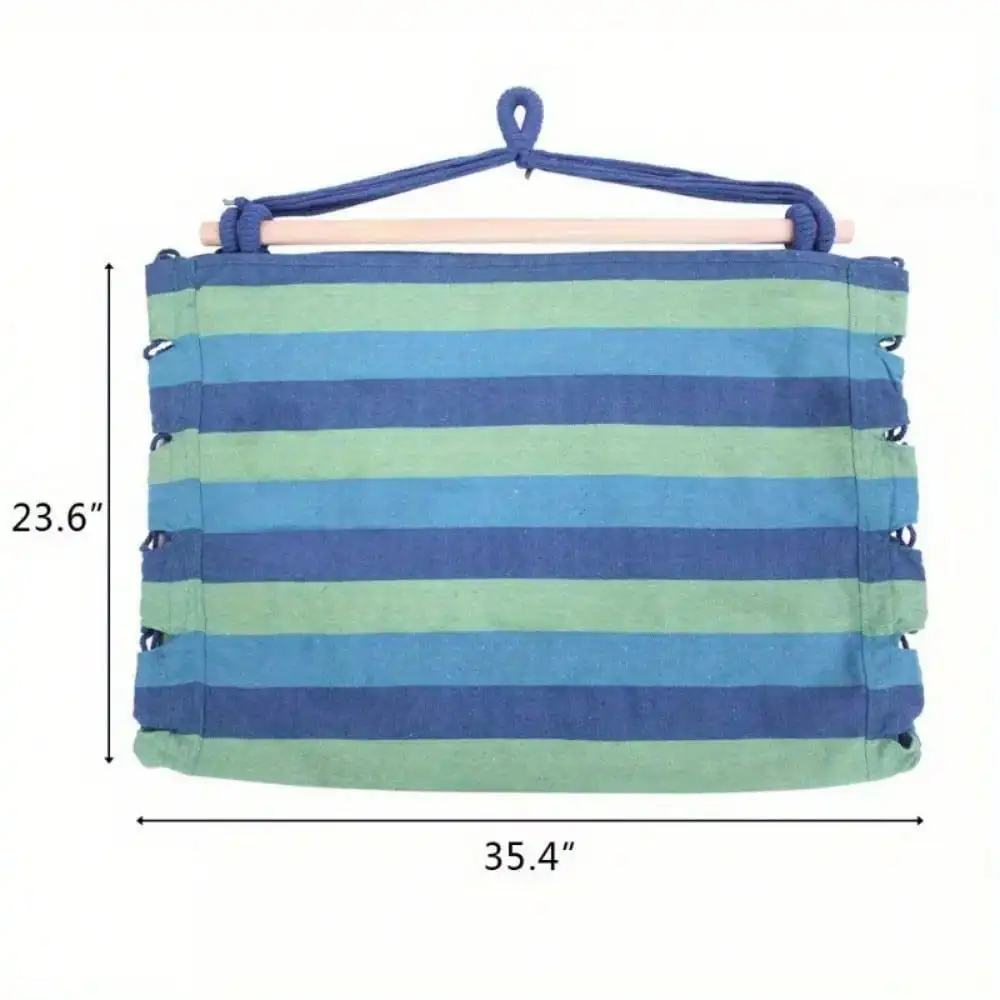
Best Fabric Choices for Specific Situations
Different environments and use patterns call for specialized fabric selections:
Full Sun Exposure (4+ hours direct sunlight daily)
Solution-dyed acrylic is the clear winner here, with premium polyester as a second choice. The UV resistance of these fabrics will prevent fading and deterioration, extending the life of your hammock swing by years.
Covered or Partially Shaded Porches
High-quality polyester offers excellent value in these settings, providing good durability without the premium price of acrylic. Cotton blends also become viable options when protected from direct weather exposure.
Humid, Coastal Environments
Olefin and solution-dyed acrylic excel in high-humidity areas, as their resistance to moisture absorption dramatically reduces mildew risk. Avoid standard cotton in these locations unless you enjoy frequent cleaning.
Family Use with Children
Olefin’s legendary stain resistance makes it ideal for families with young children or pets. Easy cleanup means less stress about spills and more focus on enjoying family time.
Year-Round Outdoor Exposure
For hammocks that will remain outdoors through all seasons, only solution-dyed acrylic and premium specialty fabrics offer sufficient weather resistance for true year-round performance.
Budget-Conscious Purchase
Quality polyester provides the best balance of performance and value, offering reasonable durability at a moderate price point. Look for solution-dyed options whenever possible.
Finding the perfect porch swing hammock comfort often means matching these environmental factors to the right fabric properties.
Critical Factors for Your Final Selection Decision
To make the optimal fabric choice for your specific situation, consider these key decision factors:
Climate Assessment
Evaluate your local weather patterns honestly. How many sunny days does your region experience? What’s the average humidity? How frequently does it rain? The answers should heavily influence your fabric choice, with harsher conditions requiring more premium materials.Porch Exposure Level
Take note of how protected your porch location is. A deep, covered porch with minimal direct sunlight allows for more fabric options than an exposed deck that receives full afternoon sun and rain exposure.Usage Patterns
Consider how frequently you’ll use the hammock swing and for how long. Daily use requires more durable fabrics than occasional weekend enjoyment. Will multiple people use it? Will children or pets be regular occupants?Maintenance Willingness
Be realistic about your maintenance habits. Are you willing to bring cushions in during rain? Will you clean spills immediately? Can you commit to regular fabric cleaning? Less maintenance-minded owners should prioritize easy-care fabrics.Budget Considerations
Determine your investment approach. Are you looking for the best long-term value (often requiring higher initial cost) or the most affordable option that meets minimum requirements? Remember that replacement costs can make “budget” options more expensive over time.Aesthetic Requirements
Consider how the hammock swing will integrate with your existing outdoor decor. Some fabric types offer limited color and pattern options, while others provide extensive design choices.Weight Capacity Needs
Heavier users or multiple simultaneous occupants require stronger fabrics with superior tensile strength. Consider both the fabric itself and how it’s attached to the frame.
Our swinging hammock chair sets collection offers options to address various combinations of these critical factors.
Maintaining Your Porch Hammock Swing Fabric for Maximum Lifespan
Proper maintenance significantly extends the useful life of any hammock swing fabric, regardless of material. Follow these guidelines to protect your investment:
Routine Maintenance (Weekly to Monthly)
– Remove loose dirt and debris by brushing with a soft-bristled brush
– Spot clean spills immediately with appropriate cleaners for your fabric type
– Rinse with clean water after cleaning to remove residual soap
– Allow to dry completely before folding or covering
Seasonal Deep Cleaning
– Solution-dyed acrylic: Mix 1/4 cup mild soap per gallon of lukewarm water, clean with soft brush, rinse thoroughly
– Polyester: Similar process to acrylic, but can also use diluted bleach for stubborn stains (test inconspicuous area first)
– Olefin: Often cleanable with just water; add mild soap only for persistent stains
– Cotton: Use cold water and mild detergent, avoid harsh scrubbing
Off-Season Storage
– Ensure fabric is completely dry before storage
– Store in breathable containers, never in sealed plastic bags
– Keep in climate-controlled spaces when possible
– Fold with acid-free tissue paper to prevent permanent creasing
Common Issue Solutions
– Mildew: Mix 1 cup bleach with 1 gallon water for synthetic fabrics (not for cotton or printed fabrics)
– Tree sap: Freeze with ice cube, then gently scrape off; treat residue with alcohol-based hand sanitizer
– Sunscreen stains: Dish soap and warm water, followed by rinse (treat immediately for best results)
Protective Treatments
– Reapply water-repellent treatments annually or when water stops beading
– Use fabric-specific protectors rather than general-purpose options
– Apply treatments to clean, dry fabric in moderate temperatures
Following these maintenance practices ensures you’ll enjoy ultimate relaxation in porch swing hammocks for many seasons to come.
DIY Considerations: Selecting and Working with Hammock Fabrics
For crafty individuals looking to create or recover their own hammock swing, fabric selection requires additional technical considerations:
Fabric Weight Guidelines
– Hammock body fabric: Minimum 7.5 oz/yd² (250 g/m²) for single occupancy
– Swing seats: 10-12 oz/yd² (340-400 g/m²) recommended for durability
– Canopies/shades: 5-7 oz/yd² (170-240 g/m²) provides sufficient protection
Calculating Yardage
– Basic hammock swing seat (18” x 48”): 1.5-2 yards allowing for seams and edges
– Double-wide seat: 3-3.5 yards minimum
– Include additional material for matching pillows or accessories
– Add 15% to calculations for pattern matching if applicable
Working with Outdoor Fabrics
– Use UV-resistant polyester thread for all seams
– Select needle size 100/16 or 110/18 for heavier fabrics
– Maintain tension to prevent puckering but avoid stretching
– Consider a walking foot attachment for thick or slippery fabrics
Reinforcement Techniques
– Double-stitch all seams with at least 1/4” seam allowance
– Reinforce corners and suspension points with extra fabric layers
– Use webbing reinforcement at stress points where hardware connects
– Box stitching or X-patterns provide maximum strength at connection points
Hardware Integration
– Create fabric channels for ropes or chains rather than direct attachment
– Use grommets or eyelets for rope/chain pass-through points
– Select stainless steel or brass hardware for corrosion resistance
– Consider removable cushion designs for easier cleaning
The process of how to install porch swing hammocks provides additional context for how fabric choices integrate with the overall construction.
Dark Wood Hammock Sets, Porch Swing Chair Sets
$653.82 Select options This product has multiple variants. The options may be chosen on the product pageA-Frame Stand Hammock Sets, Swinging Hammock Chair Sets
$154.62 Select options This product has multiple variants. The options may be chosen on the product pageLight Wood Hammock Sets, Swinging Hammock Chair Sets
$1,359.35 Select options This product has multiple variants. The options may be chosen on the product pageDouble / Two Person Hammock Sets, Rope Hammock Sets
Double Traditional Cotton Rope Hammock with Extension Chains – 450 lbs Capacity for Backyard & Patio$292.98 Select options This product has multiple variants. The options may be chosen on the product page- $963.29 Select options This product has multiple variants. The options may be chosen on the product page
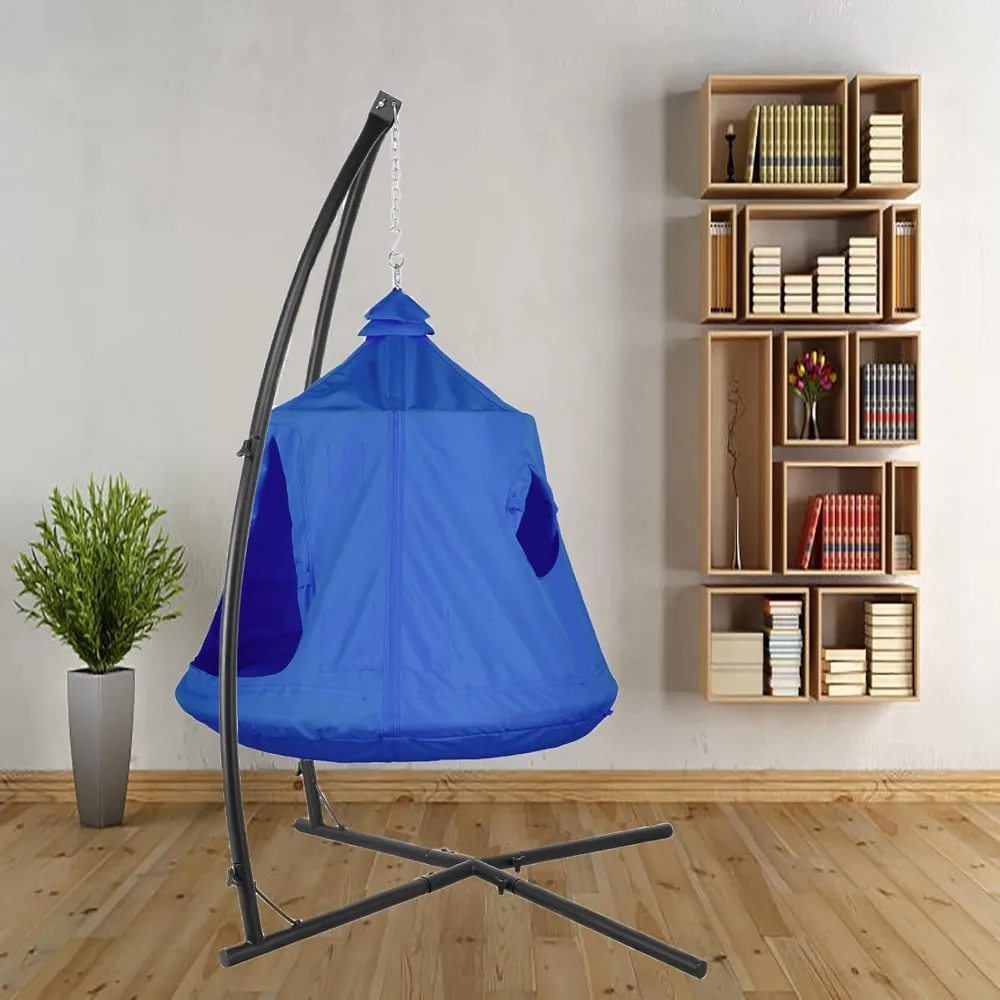
Frequently Asked Questions About Hammock Swing Fabrics
Q: How much weight can different fabric types support?
A: Weight capacity depends more on construction than fabric type. However, tightly woven synthetic fabrics like solution-dyed acrylic and heavy polyester typically offer superior tensile strength. Most commercial hammock swings are rated for 250-450 lbs depending on design and materials.
Q: Which fabrics are safest for children?
A: Look for fabrics with rounded edges, no exposed hardware, and secure stitching. Olefin fabrics offer excellent stain resistance for messy little ones, while solution-dyed acrylics provide superior durability. Avoid fabrics with chemical treatments if children have sensitive skin.
Q: Are there truly pet-friendly fabric options?
A: Olefin and solution-dyed acrylic best resist pet claws and occasional accidents. Tight weaves resist snags, while smooth textures discourage pets from scratching. Consider darker colors or patterns that mask pet hair between cleanings.
Q: What are the most eco-friendly fabric choices?
A: Organic cotton is biodegradable but less durable outdoors. Better environmental options include recycled polyester (made from plastic bottles) and fabrics with OEKO-TEX certification ensuring limited harmful substances. Several manufacturers now offer fabrics made from up to 100% recycled ocean plastic.
Q: What fabric certifications should I look for?
A: Reputable certifications include GREENGUARD (low chemical emissions), OEKO-TEX (tested for harmful substances), and Solution-Dyed certification (for colorfastness). Performance fabrics may carry additional ratings for UV resistance (UPF) and water repellency.
For additional guidance on fabric selection for multiple users, our two person hammock fabrics guide provides specialized insights.
Premium Picks: Our Top Fabric Recommendations
After extensive testing and customer feedback analysis, we’ve identified these standout fabric options for porch hammock swings:
Best Overall: Sunbrella® Acrylic
The industry benchmark for a reason, Sunbrella combines exceptional fade resistance (maintaining 95% color after 1,500 hours of UV testing), superb water repellency, and surprisingly soft texture. Its 5-year warranty against fading makes it the ideal choice for exposed locations with direct sunlight. Available in over 200 colors and patterns.
Best Value: Solution-Dyed Polyester
At roughly half the price of premium acrylic, high-quality solution-dyed polyester delivers 70-80% of the performance. Look for options with 7-8 oz/yd² weight for hammock applications. Expect 2-3 years of color retention in partial sun exposure—an excellent middle-ground option for most situations.
Most Comfortable: DuraCord®
This proprietary blend combines cotton’s soft feel with synthetic durability, creating a uniquely comfortable experience. The material breathes well in hot weather while offering good moisture resistance. Though slightly less fade-resistant than pure synthetics, it excels in comfort for those who prioritize the tactile experience.
Most Durable: Textilene® Mesh
For challenging environments with extreme weather exposure, Textilene’s PVC-coated mesh construction offers unmatched durability. Virtually impervious to moisture, it dries instantly after rain and resists fading for 5+ years. The open weave provides excellent ventilation on hot days, though some users find it less comfortable against bare skin.
Best Eco-Friendly Option: Recycled Polyester
Modern recycled polyester fabrics, often made from reclaimed plastic bottles, offer performance nearly identical to virgin polyester with significantly reduced environmental impact. Look for options with at least 50% recycled content that maintain solution-dyed properties.
For those seeking alternative traditional options, our rope hammock sets provide a different aesthetic and feel.
Beyond the Fabric: Other Factors Affecting Your Hammock Swing Experience
While fabric selection is crucial, several complementary factors significantly impact your hammock swing’s overall performance and longevity:
Structural Considerations
– Frame design affects how fabric tension is distributed
– Proper suspension systems prevent uneven wear
– Quilted fabrics distribute weight more evenly than single-layer options
– Reinforced edges and stress points extend fabric life substantially
Tension Management
– Proper initial tension setup prevents premature stretching
– Adjustable systems allow tension correction as fabric naturally relaxes
– Over-tightening accelerates wear at attachment points
– Under-tensioning creates uncomfortable sags and potential safety issues
Protective Accessories
– Weather-resistant covers extend fabric life during harsh weather
– Removable cushions allow for separate maintenance schedules
– Canopies and shade elements reduce direct UV exposure
– Detachable rain flies protect during sudden weather changes
Fabric Care Products
– Fabric-specific cleaners preserve protective treatments
– UV protectant sprays supplement built-in resistance
– Water repellent refreshers restore beading capabilities
– Professional cleaning services for deep restoration
Consider how these elements work together with your fabric choice to create an integrated system that maximizes both enjoyment and longevity. Each component contributes to the overall performance of your hammock swing.
Is Weather-Proofing Spray Worth It for Your Hammock Fabric?
The effectiveness of after-market fabric treatments depends significantly on your specific fabric type and environmental conditions. Here’s what you need to know about these supplemental protectants:
Types of Protective Treatments
– UV Protectant Sprays: Add a sacrificial layer that absorbs UV radiation before it reaches the fabric
– Water Repellent Treatments: Enhance the surface tension that causes water to bead and roll off
– Antimicrobial Sprays: Create an inhospitable environment for mold and mildew spores
– All-in-One Protectors: Combine multiple protective properties in a single application
When Additional Treatment Makes Sense
– Premium acrylic fabrics rarely need additional UV protection but may benefit from water repellent refreshers after 2-3 years
– Polyester fabrics show measurable benefits from annual UV protectant applications
– Cotton absolutely requires water repellent treatment for outdoor use
– Any fabric stored during winter benefits from antimicrobial treatment before storage
Application Best Practices
– Apply to completely clean, dry fabric
– Use multiple light coats rather than one heavy application
– Maintain 65-75°F temperature during application for optimal bonding
– Allow 24-48 hours of dry time before exposure to moisture
Effectiveness Duration
– Quality UV protectants typically last 3-6 months of regular sun exposure
– Water repellents remain effective for 6-12 months depending on rainfall exposure
– Antimicrobial treatments generally need annual reapplication
Potential Downsides
– Some treatments can stiffen fabric slightly
– Improper application may create spotting or discoloration
– Breathability may be reduced, especially with heavy application
– Some formulations contain VOCs or other chemicals of concern
The value proposition for these treatments varies: they’re essential for cotton, beneficial for polyester, and optional for premium acrylics. Consider them as maintenance tools rather than transformative upgrades—they extend the performance of appropriate fabrics but won’t fundamentally change a fabric’s base characteristics.

